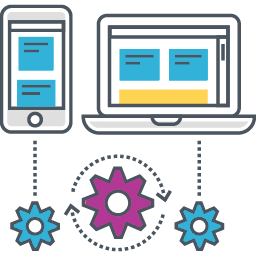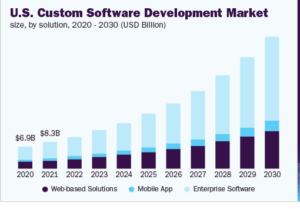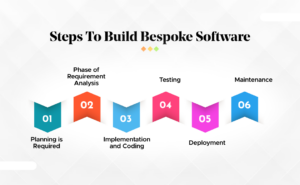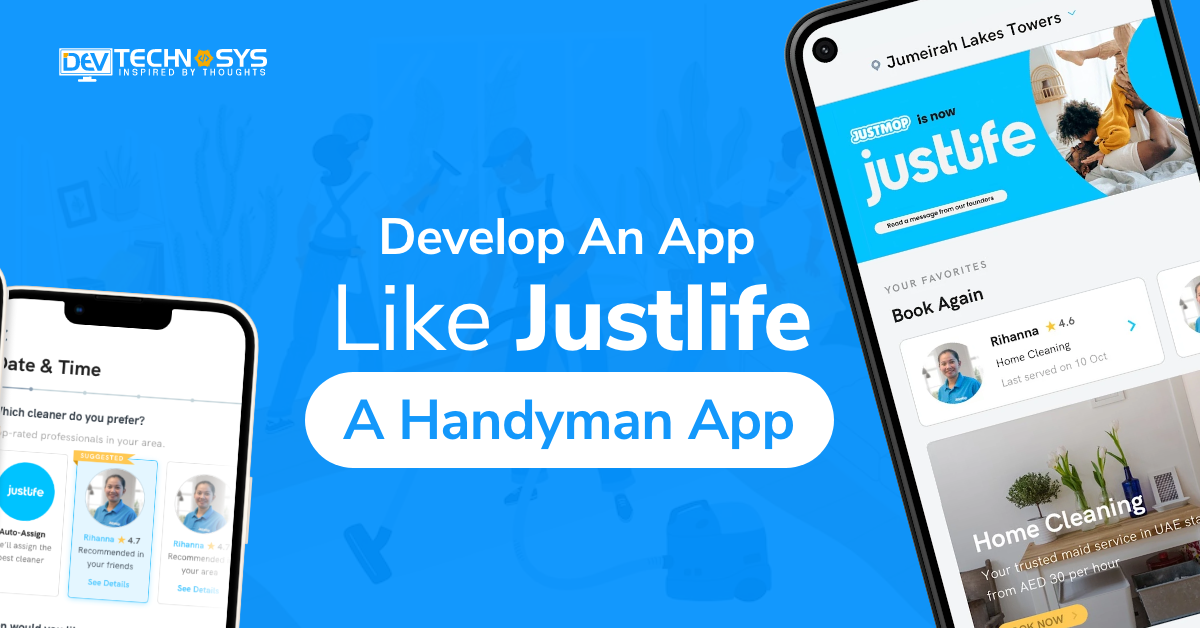“Custom software empowers businesses to break free from limitations and unleash their full potential.”
Steve Jobs
Should you choose a Bespoke Software Development or go for an off-the-shelf application? Making this choice might be difficult for many corporate executives. You may find it stressful to face business challenges and we know that your business is important to you. It gets worse when you can’t solve your problems with off-the-shelf software.
You have made the right decision if, after analyzing your specific business challenges, you decide to bespoke software. The IT expenditure on custom enterprise software will be around USD 599 Billion in 2021. This statistic should be enough to justify your decision.
Amazon is one of the largest e-commerce companies that use custom software with Artificial Intelligence to collect data about customer preferences. Custom software’s algorithm understands exactly what customers need, and improves the online shopping experience for all.
If you run a small business, medium-sized business, or large enterprise, custom software will help your business grow. Let’s start learning bespoke software development for your business.
What is Bespoke Software Development?

Bespoke software development is the process of creating applications to meet the problems customers in large businesses encounter. This involves writing code using programming languages like Java, Python, C++, or others to create software applications that run on various platforms such as desktop computers or mobile devices.
The software development process is usually divided into several stages: planning, designing, and coding. Testing, deployment, and testing are also included. During the planning phase, developers collaborate with clients or other stakeholders to determine the needs of the software application. This includes its features, functionality, and user interface.
Researchers may also carry out research to find similar software applications on the market and gain insights into users’ behavior. By leveraging bespoke software development services, organizations can restructure their processes to better serve customers’ requirements.
Software Development Market Statistics

- The Software Market is expected to generate US$659.00bn by 2023.
- Enterprise Software has the largest market share within Software, with a market volume projected to be US$271,80bn by 2023.
- The market is expected to grow at a rate of 5.42% per year (CAGR from 2023-2028), resulting in an estimated US$858.10bn of revenue by 2028.
- The United States will generate the largest amount of revenue (US$338.20bn by 2023).
- By 2022, almost 65 percent of software engineers will be using JavaScript, the most popular programming language for software development.
- In 2021, the enterprise software segment will account for over 55.0% of revenue.
- California is the state with the highest average salary for software developers.
- Software developers are among the 26.9 million worldwide.
- Javascript was used by nearly 70% of developers in the last 12 months.
- In the US, over 80% of all developers are men.
Why Do You Need to Invest In Bespoke Software Development?
You can now determine if the time is right to start developing bespoke business software. Or, what are the main reasons to develop custom software?
1. Your Business Processes and Workflows Need to be Optimized and Streamlined
Different business practices and activities are used by different enterprises in the same industry. Businesses should adapt workflows in order to match standard operating procedures. So you want to optimize a business process or streamline an operation in accordance with your requirements. Then, you should consider custom software development.
2. Modernization and Adaptability Are Keys to Your Business
It is essential to be aware of and to respond to new trends in today’s dynamic business environment. Otherwise, your business will be extinct soon. Custom software that adapts to changing market conditions will help businesses achieve their goal.
Consider wanting to boost the worth of your company by introducing goods and services before the competitors. You could find it easier to incorporate system modifications if you use custom software.
3. You Want to Scale Up
When building software or website, business owners are concerned with one main question: Will it last? Will the software scale as the company grows and technology advances?
However, custom software development can solve these problems and overcome unexpected obstacles. Custom software can be future-proofed, as it allows developers to add new technologies to the software development process.
As your organization expands, custom software development enables you to prepare for better business operations and future growth.
Custom Software vs. Off-The-Shelf Software
Below is the comparison table of Custom Software vs. Off-The-Shelf Software that is approved by a bespoke software company. So let’s have a look:
| Custom Software | Off-The-Shelf Software |
| Customized solutions to meet the needs of users | It is suitable for a large audience |
| Flexible, but potentially labor-intensive and costly | Costs that are less flexible but more predictable |
| Includes only necessary functions | Features rich, but many functions are unused or unneeded |
| The company retains ownership, and so does the maintenance and upgrade schedule. | You are at the mercy (and the app’s lifecycle) of the publisher’s maintenance and upgrade schedule. |
Bespoke Software Development: 5 Benefits

Custom software development is a great way to improve business processes, customer interaction, and collaboration between departments and partners. Let’s look at the benefits of bespoke software in more detail to see if they’re worth your investment.
Benefit 1: It Meets Unique Business Needs
Every organization is different, with its own set of difficulties, requirements, and workings. This contains the desired security requirements. Customized software offers individualized solutions that make it simple to enhance and add new features as your organization develops.
Benefit 2: Automates Manual Operations
Manually running a business is time-consuming and costly. It’s not efficient, especially for enterprises with high engagement. Repetitive manual tasks may be automated by custom software, freeing up team members and corporate executives to focus on more crucial matters. Everything is more productive as a result.
Benefit 3: It Saves Funds
Businesses sometimes choose off-the-shelf solutions because they think that they are quicker to develop and easier to incorporate. This approach is not scalable and will make it harder to add new features in the future. Multiple solutions might wind up costing money, which would raise the overall cost of operations.
Benefit 4: It Offers Better Security Control
Business operations and cyberattacks are both continually changing. Hackers might target commercial solutions since they are already familiar with how they are created and function. Because a customized solution is private, hackers will have to spend more time researching the adjustments. To further strengthen the system’s security, additional security features like encryption can be included.
Benefit 5: It is Easy to Update Legacy Systems
To improve efficiency, software engineers can recode legacy software systems to integrate modern technology.
How to Build Bespoke Software?

Here we will explain the different phases of bespoke software development in more detail. Clients who have an application need will search for agencies and professionals who can create the application. After the client has hired a drone software development company if he wants to create drone software, he will meet the project manager and sign the contract, and the first phase begins.
1. Planning is Required
The requirements for the application are outlined in this phase. The client will define the features and the usability of the app for the IT team. Every software project is different based on the end goal.
In this phase, the product requirements from the perspective of the customer are collected and a mutual agreement is reached between the project manager and the client. This phase produces a document of mutually agreed requirements or an original outline. Multiple iterations will occur during this course. New requirements and features are also added.
2. Phase of Requirement Analysis
The team, which includes the product owner, testers, and developers, will then analyze the requirements and give details about how the software is to be developed. Additionally, the team will discuss possible solutions, outputs, inputs, and resource allocation within the project.
The team may divide the project into smaller, more manageable tasks. This phase describes how the team will translate client requirements into features and functionality in the software.
3. UI/UX Design
The design phase begins after the features and requirements have been established. You must hire bespoke software developers who can design the product after considering all requirements.
During this phase, a product is designed, taking into account the user interface, business rules, and color scheme. The decision is made on the programming languages, frameworks, server design, database relationship, the architecture of the app, mobile aspects, supported web browsers, etc.
4. Implementation and Coding
In this phase, the team responsible for setting up the physical servers will begin writing code. Designers will plan the interface and testers will analyze the design. The testers also begin building test cases to support their test plans. The testers begin by evaluating the usability and coordination of the application. They can also help fix the flaws and errors that are found in the early stages.
5. Testing
Once the developers are done coding the app, testing begins. This phase is crucial for identifying errors and bugs. In addition, this phase is responsible for the security of the software. The testers will verify that the servers are working, the database has been set up correctly and the application meets the requirements.
They ensure that the product is not different from the original plan. They also verify that all requirements are met, features work, and errors have been fixed. Testing leads to more bugs being found, so this phase is crucial. The bug-tracking software is notified of these bugs and errors.
These issues are then assigned to developers. Developers send back the product to the testing team once the problem is resolved. The bug life cycle is the process of finding and fixing bugs. This will ensure that the final product is perfect.
6. Deployment
In this phase, the team of operators will deploy the product. This phase is when the final application will be ready for production. In this phase, the final application is ready for production. The application will go live once the deployment is complete.
7. Maintenance
The SDLC ends here. The final product that goes live is monitored to make sure the user experience is seamless and that the system works properly. This phase includes product support where software developers respond to customer queries and complaints. When you deploy the product, new errors can then appear. Developers will fix the bugs by fixing issues with the application.
Popular Software Development Methodologies

A team selects a set of software tools and procedures to be used for software product design, software testing, software management, and other software development activities. The team’s goal and the goals of the product to be developed will determine the choices they make. These are the most popular bespoke software development models that experts can use with experienced teams in the IT industry.
1. Waterfall Methodology
The waterfall model can be described as a sequential linear life cycle model. It is a popular life cycle software approach. The waterfall model is a popular and old methodology that you can use for any project.
The waterfall technique is a sequential strategy that doesn’t interfere with the creation of unique software. You can save time and money. The waterfall method works like a waterfall with a set of defined phases.
2. Agile Methodology
Agile is a more advanced version of a waterfall, as it was developed to address the challenges that a waterfall presents. It is flexible when we compare it to the waterfall. It begins with a simple project design, where the developer assigns a completion date for each module.
You can give feedback after each successful module. The testers will fix the bugs later and the code quality will then monitor.
Agile allows software developers to continuously change their projects according to the project requirements. The bespoke software developers can then go back and correct the mistake.
3. Spiral Model Methodology
As the name implies, the spiral model begins with the smallest section of software development before moving on to the largest section. Many app development companies employ the spiral model to carry out systemic flow.
It is important to use the spiral model because it eliminates risk at an early stage. This is a systematized model, making it easy to streamline development.
4. Scrum Development Methodology
The Scrum method divides the project into smaller groups and assigns each group a specific strategy. Scrum is the best way to Build bespoke software quickly and see rapid changes. It allows for multiple iterations at once.
Scrum starts with a short plan, followed by a thorough analysis. The developers will then implement the development process. You need to have a cross-functional team of engineers who are proficient in requirements analysis, design, coding, and testing. 70% of businesses adopt the scrum technique, according to the 12th Annual State of Agile Report.
5. Big Bang Methodology
Big Bang is the ideal method for entrepreneurs that are unaware of their requirements or do not have an accurate vision of the outcome. It is therefore best for simple and small projects. It does not have rigid protocols or complicated formal procedures.
Your project won’t require previous planning. Due to the low resource requirements, it is simple to manage. If you want to utilize it on intricate or sizable tasks, it could be problematic.
How Much Does Bespoke Software Development Cost?
The cost to develop software can vary greatly depending on a number of factors. Here are some factors that will influence the cost.
- Scope and complexity
- Features and functionalities
- Technology Stack
- Customization and integration
- Development Team
- Maintenance and Support
It is important to remember that it’s difficult to provide an exact estimate without knowing the details of the project. Custom software development can cost anywhere from $25000 to $33000 for simple, small applications, up to $35000 and $50000 for complex, large enterprise systems.
We recommend consulting a software development company or hire dedicated developer for a more accurate estimation based on your needs.
Conclusion
Entrepreneurs will need to keep up with the latest technologies. It is essential to understand how software development works. To begin working on bespoke software development that is tailored to your needs, you should first identify them. The project will then be customized as much as possible. The process will go more quickly if you do this.
However, you must be aware of what you’re getting into if you hire a SaaS or software development company. A client who is well-informed can provide better advice to any partner working on software.
FAQ
How Do You Calculate the Cost of Software Development?
You can divide software development costs into two broad categories: ballpark or detailed. A ballpark estimate gives you a rough idea of the cost to develop an app. The detailed estimate, on the other hand, is calculated more precisely.
What is the Hourly Rate for Mobile App Developers?
The hourly rates for mobile app developers who can build mobile apps can be affected by factors like location, experience and skill set. The average rate for developers is $15-$25 per hour. Junior developers charge lower rates, while senior or specialized developers demand higher fees.
What Types of Services Are Available for Custom Software Development?
Custom software development includes four types: Mobile app development (also called mobile application development), eCommerce development (also known as SaaS development), product development, and SaaS development.
What Types of Custom Software Are Available?
- Content Management Systems (CMS).
- Customer Relationship Management (CRM).
- Enterprise Resource Planning Software
- Operations Management Software
Enterprise bespoke software solutions.
What Are Some Examples of Custom-Made Software?
- Streaming services
- Video streaming services
- Voice Recognition Services
- Customized software for Banking
- Delivery software





















